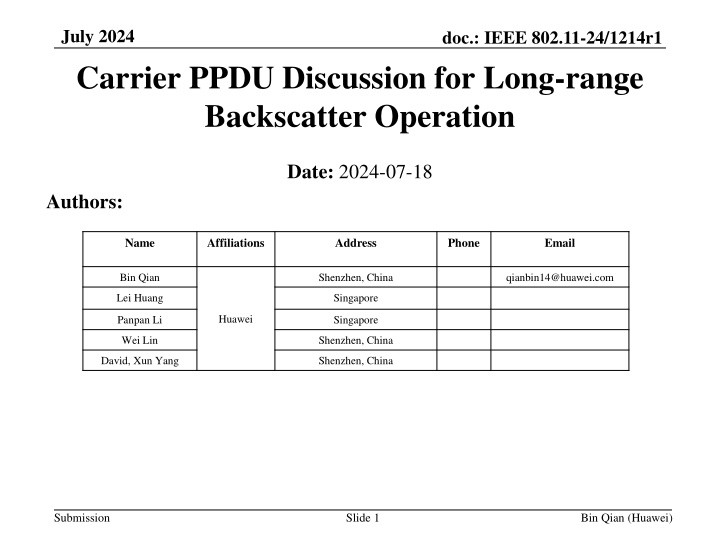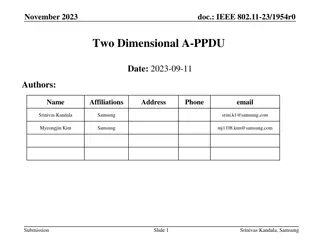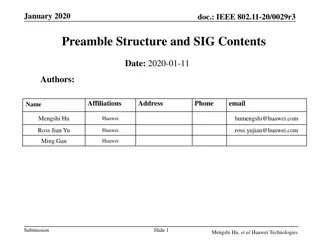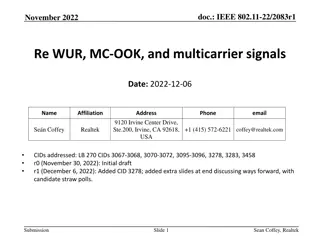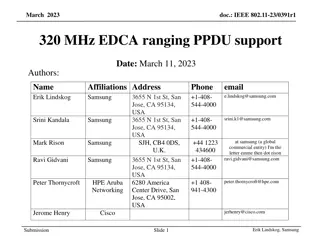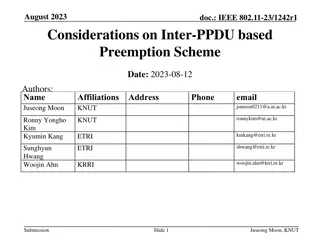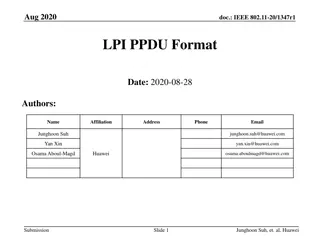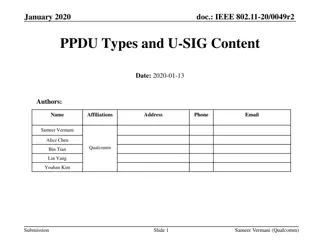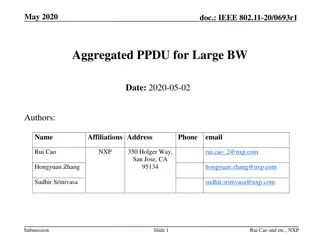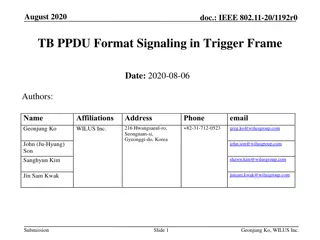Carrier PPDU Discussion for Long-range Backscatter Operation in IEEE 802.11-24
This document discusses the use of Carrier PPDU for long-range backscatter operation in IEEE 802.11-24 standard. It covers topics such as close-range and long-range backscatter in AMP, reader PPDU for close-range operation, and different topologies to support long-range backscatter. The content includes detailed explanations, diagrams, and examples provided by Bin Qian from Huawei.
Download Presentation

Please find below an Image/Link to download the presentation.
The content on the website is provided AS IS for your information and personal use only. It may not be sold, licensed, or shared on other websites without obtaining consent from the author.If you encounter any issues during the download, it is possible that the publisher has removed the file from their server.
You are allowed to download the files provided on this website for personal or commercial use, subject to the condition that they are used lawfully. All files are the property of their respective owners.
The content on the website is provided AS IS for your information and personal use only. It may not be sold, licensed, or shared on other websites without obtaining consent from the author.
E N D
Presentation Transcript
July 2024 doc.: IEEE 802.11-24/1214r1 Carrier PPDU Discussion for Long-range Backscatter Operation Date: 2024-07-18 Authors: Name Affiliations Address Phone Email Bin Qian Shenzhen, China qianbin14@huawei.com Lei Huang Singapore Huawei Panpan Li Singapore Wei Lin Shenzhen, China David, Xun Yang Shenzhen, China Submission Slide 1 Bin Qian (Huawei)
July 2024 doc.: IEEE 802.11-24/1214r1 Abstract This contribution intends to discuss the Carrier PPDU used for AMP long-range backscatter operation Submission Slide 2 Bin Qian (Huawei)
July 2024 doc.: IEEE 802.11-24/1214r1 Recap: Close-range Backscatter in AMP The close-range backscatter use case has been discussed in [1-3] Mono-static: the Carrier Source and AMP reader are integrated Wi-Fi transceiver has 2+ antennas to support full-duplex operation Coverage: 10 cm - 20 cm Leakage signal The transmitted input carrier can leak directly into the receiver, which can be significantly stronger than the backscattered signal from the tag Submission Slide 3 Bin Qian (Huawei)
July 2024 doc.: IEEE 802.11-24/1214r1 Recap: Reader PPDU for Close-range Backscatter Operation An AMP Reader PPDU example structure is provided in [3] Reference Symbol(s) Wi-Fi preamble Carrier Symbols Wi-Fi Preamble is used to provide better coexistence with legacy Wi-Fi devices Reference Symbols are used by the AMP reader to estimate the Tx-Rx leakage channel to mitigate leakage by subtracting the leakage signal from the received signal Carrier Symbols are used by the AMP tag to generate the backscattered signals The Reader PPDU is transmitted by the AMP reader Submission Slide 4 Bin Qian (Huawei)
July 2024 doc.: IEEE 802.11-24/1214r1 Long-range Backscatter in AMP Another topology is also discussed in the group to support the long-range backscatter operation in AMP [4] Bi-static: the Carrier Source and AMP reader are separated, which results in half duplex operation Coverage: several meters This configuration suffers from the direct path interference problem. The direct signal component can be several orders of magnitude stronger than the backscattered signal Submission Slide 5 Bin Qian (Huawei)
July 2024 doc.: IEEE 802.11-24/1214r1 Carrier PPDU for Long-range Backscatter Operation The Carrier PPDU for long-range backscatter is transmitted by the Carrier Source The Carrier PPDU has at least the following components and functions Wi-Fi Preamble: Provide the coexistence with legacy Wi-Fi devices Reference Symbols: Enable accurate estimation of the direct path to compensate the direct path interference to enhance the reader s ability to detect and process the desired backscattered signals Carrier Symbols: Provide carrier symbols for the tag to modulate information Field duration example Wi-Fi Preamble: 20 us; Reference Symbols: 8 us; Carrier Symbols: 640 us (20 octets at 250 kbps) Submission Slide 6 Bin Qian (Huawei)
July 2024 doc.: IEEE 802.11-24/1214r1 Start Time of Backscattered Signal In the long-range backscatter use case, both the AMP reader and AMP tag need to synchronize the start time of the backscattered signal The AMP reader starts to decode the backscattered signal after this point The AMP tag starts to modulate information on the carrier symbols after this point Submission Slide 7 Bin Qian (Huawei)
July 2024 doc.: IEEE 802.11-24/1214r1 Start Time Indication of Backscattered Signal (1/5) An AMP packet is transmitted by the AMP Reader to trigger the transmission of the Carrier PPDU The AMP tag detects this AMP packet and then waits for a certain duration (denoted as T_tag) to determine when the reference symbols end and the carrier symbols begin Ideally, T_tag = SIFS + T_pre + T_ref Submission Slide 8 Bin Qian (Huawei)
July 2024 doc.: IEEE 802.11-24/1214r1 Start Time Indication of Backscattered Signal (2/5) However, due to the large clock error of the AMP tag, e.g., 10k ppm 100k ppm, the time drift is significant Case A: T_tag is larger than (SIFS + T_pre + T_ref) A part of the decoded data at the AMP reader is not valid (red area) A known bit pattern, i.e., a delimiter (blue area), could be used at the beginning of the backscattered signal to indicate the start of the valid data Submission Slide 9 Bin Qian (Huawei)
July 2024 doc.: IEEE 802.11-24/1214r1 Start Time Indication of Backscattered Signal (3/5) Case B: T_tag is smaller than (SIFS + T_pre + T_ref) A part of the valid backscattered signal (green area) is lost by the AMP reader Submission Slide 10 Bin Qian (Huawei)
July 2024 doc.: IEEE 802.11-24/1214r1 Start Time Indication of Backscattered Signal (4/5) Regarding Case B, an extra duration T_extra could be preset by the AMP Tag to make sure the backscattered signals are generated by Carrier Symbols instead of Reference Symbols Submission Slide 11 Bin Qian (Huawei)
July 2024 doc.: IEEE 802.11-24/1214r1 Start Time Indication of Backscattered Signal (5/5) Since the AMP Tag does not know it is Case A or Case B, the extra duration T_extra will be used in both cases T_extra is set such that even in the worst case, T_tag + T_extra > SIFS + T_pre + T_ref Submission Slide 12 Bin Qian (Huawei)
July 2024 doc.: IEEE 802.11-24/1214r1 Summary Some details of the Carrier PPDU for the long-range backscatter operation is discussed Carrier PPDU format Start time indication of the backscattered signal Aspect Start time indication of the backscattered signal Complexity Low: Simple delimiter pattern detection at the AMP reader side Clock Accuracy Requirement Low: Tolerant to clock drift Robustness High: Robust to timing inaccuracies, no cumulative errors Implementation Simple: requires delimiter detection at the AMP reader side Use case Most scenarios, especially with significant clock drift Submission Slide 13 Bin Qian (Huawei)
July 2024 doc.: IEEE 802.11-24/1214r1 References [1] 11-23-2038-01-0amp-close-range-amp-backscattering-in-2.4ghz [2] 11-24-0537-00-0amp-close-range-amp-wifi-reader-feasibility-study [3] 11-24-0798-01-00bp-close-range-amp-wifi-reader-feasibility-study- followup [4] 11-24-0867-00-00bp-thoughts-and-questions-on-amp-phy Submission Slide 14 Bin Qian (Huawei)
